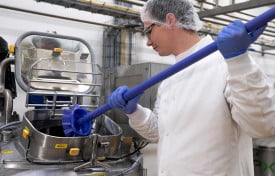Monthly Archives: April 2014

- April 23, 2014
Employees can track in a myriad of potential contaminants and unknowingly put an operation at risk each time they breeze through a doorway to a production area. The effective use of a Disinfectant Mat™ provides a significant defense against cross-contamination. As employees step onto the mats, footwear is cleaned and sanitized. This barrier can help stop cross-contamination in its tracks.
Some plant managers complain that employees don't use them. Others say that they don't get cleaned out often enough or, the sanitizing solution loses effectiveness, creating a source of contamination. Yes, these things can happen but they don't have to, as each of these problems have a simple answer.
- April 23, 2014
Why Insulate?
- Prevent contamination from condensation dripping off pipes.
- Easier to keep pipes clean.
- Saves energy.
- Avoid employee burns.
- Better temperature control of process or CIP lines.
- Reduce noise.
- Improve appearance.
- April 23, 2014
Effectively caring for your cutlery can help maximize its performance and extend its life. Below is a list of our recommendations.
Hand Wash
After each use, carefully wash cutlery by hand with warm water and mild- to medium-strength soap; rinse and thoroughly dry with a soft towel.
Avoid Dishwashers
Knives should NOT be placed in automatic dishwashers. The blade edges can dull from rubbing against each other, and caustic detergents can cause staining and pitting of the blade.
Avoid Soaking
Cutlery should NOT be soaked for long periods or submerged for cleaning. Galvanic action, the transfer of electrons from one metal to another, may occur if cutlery is soaking in aluminum pans or stainless steel sinks, which can cause pitting on the blades.
Avoid Chlorine & Bleach Products
There is a tendency for chlorine and bleach products to discolor
- April 23, 2014
The Cut-Resistant Glove Selection Guide is a resource that evaluates the abrasion, cut, tear, and puncture levels of various glove materials. This guide serves as a tool for individuals seeking to make informed decisions about the most suitable cut-resistant gloves for their specific applications. By utilizing the Cut-Resistant Glove Selection Guide, users can gain insights into the unique properties of different materials, allowing them to match the gloves to the precise requirements of their work environments. This guide provides essential information to ensure optimal hand protection. Make use of this guide to navigate the complexities of cut-resistant gloves and choose the ones that best align with your application's needs.
- April 23, 2014
Experience enhanced precision and clarity in cut resistance standards with the introduction of the new ANSI standard, featuring nine distinct cut levels. This progressive update significantly narrows the gaps between each level, offering a more refined and precise categorization for cut-resistant gloves and sleeves, particularly those with the highest gram scores.
The accompanying graph illustrates the discernible difference between the old scale and the new scale, providing a visual representation of the improved granularity in cut level classification. Notably, the new ANSI cut scores will bear an "A" prefix, further distinguishing them from the previous standards. Embrace the heightened accuracy and specificity of the updated ANSI standard, ensuring a more nuanced understanding and selection of cut-resistant gear tailored to your specific safety requirements.
- April 23, 2014
The Hazard Communication Standard (HCS) (29 CFR 1910.1200(g)), revised in 2012, requires that the chemical manufacturer, distributor, or importer provide Safety Data Sheets (SDSs) (formerly MSDSs or Material Safety Data Sheets) for each hazardous chemical to downstream users to communicate information on these hazards. The information contained in the SDS is largely the same as the MSDS, except now the SDSs are required to be presented in a consistent user-friendly, 16-section format. This brief provides guidance to help workers who handle hazardous chemicals to become familiar with the format and understand the contents of the SDSs.
Section 1: Identification
Section 2: Hazard(s) Identification
Section 3: Composition/Information on Ingredients
Section 4: First-Aid Measures
Section 5: Fire-Fighting Measures
Section 6: Accidental Release Measures
Section 7: Handling and Storage
Section 8: Exposure Controls/Personal Protection
- April 23, 2014
Decibels (db) are a measurement of environmental noise. This chart from the United States Department of Labor showcases a spectrum of sounds and their decibel levels.
When looking into hearing protection devices, you will see the acronym: "NRR." The noise reduction rating (NRR) refers to the amount of sound (dB) reduction a hearing protection device provides when worn properly.
The higher the NRR number, the more hearing protection. For example, a pair of NRR: 30 rated earplugs would provide more auditory protection than a NRR: 27 rated pair of earplugs.
OSHA standards require the use of ear protection for employees that are exposed to noise at or above 85 dB for an 8 hour weighted average.
- April 23, 2014
Precision thermometers often face the challenge of separated mercury columns, a leading cause of instrument failure. To address this issue without causing damage, specific procedures must be followed diligently. The cooling method involves gradually immersing only the bulb in a dry-ice and alcohol solution, allowing the mercury column to retreat into the bulb. The thermometer is then swung in a short arc to force all the mercury into the bulb. Avoid cooling the stem or mercury column, and exercise caution not to touch the bulb until the mercury emerges. The heating method is applicable to thermometers with a maximum range of 260°C or 500°F, using a beaker of liquid with a flash point above the thermometer's highest indication. Immerse the bulb and stem, heat, and tap to reunite the columns. For organic-filled thermometers, tapping the stem gently against the hand can help rejoin the separated columns. Following these procedures ensures extended instrument life and successful reunification.
- April 23, 2014
Accurate pH analysis is critical in Food Processing areas and Laboratory settings. Small variances may impact food quality, safety, shelf-life, flavor, and consistency. All pH electrodes should be calibrated to pH meters with fresh, unused calibration buffers that bracket the pH value of the product being tested.
For food samples that have a pH range between 4 and 7, electrodes should at a minimum be calibrated using 4.01 and 7.00 pH calibration buffers. Electrodes for samples between 1.68 and 4 should be calibrated with 1.68 and 4.01 pH buffer. For samples between 7 and 10 pH, buffers 7.00 and 10.01 pH are recommended. Also available is 12.46 pH buffer for very high pH products.
Listed above are the most common pH calibration buffers (1.68, 4.01, 7.00, 10.01 and 12.46 pH at 25°C) and many pH meters automatically recognize these values during a calibration procedure. Although not used for calibration, Nelson-Jameson also has 5.00 pH buffer available that is commonly
- April 23, 2014
For everyone in the dairy value chain, the thought of milk contamination is simply unthinkable.
We know that for farmers and their families, competition is tough and professionalization of farming is essential for you to survive and succeed.
Ultimately, healthy products equal healthy profits. This is where the Delvotest can help ensure that any antibiotics given in the herd don't appear in the milk sold.
The Delvotest is a proven, highly respected antibiotic residue testing kit that provides the global dairy value chain (including farmers, dairies, and milk control labs) with peace of mind for a relatively modest investment.
This solution can detect all major antibiotic residues and is suitable for all kinds of milk including cow, sheep, goat, and even buffalo. The kit itself comes in different sizes: So for dairies and milk control labs, we offer larger testing kits, while for farmers we provide a smaller pack with an easy-to-use tray.
Increasingly,







